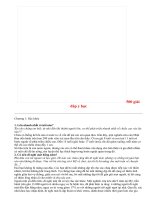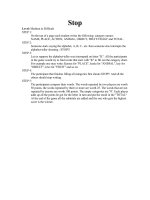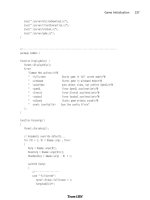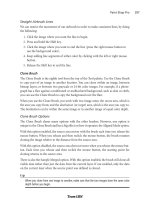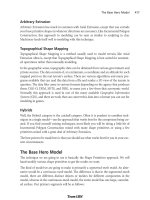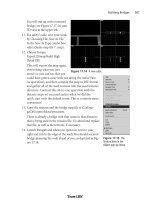One stop doc immunology stewart, john, sadler, amy
Bạn đang xem bản rút gọn của tài liệu. Xem và tải ngay bản đầy đủ của tài liệu tại đây (3.36 MB, 153 trang )
ONE STOP DOC
Immunology
One Stop Doc
Titles in the series include:
Cardiovascular System – Jonathan Aron
Editorial Advisor – Jeremy Ward
Cell and Molecular Biology – Desikan Rangarajan and David Shaw
Editorial Advisor – Barbara Moreland
Endocrine and Reproductive Systems – Caroline Jewels and Alexandra Tillett
Editorial Advisor – Stuart Milligan
Gastrointestinal System – Miruna Canagaratnam
Editorial Advisor – Richard Naftalin
Musculoskeletal System – Wayne Lam, Bassel Zebian and Rishi Aggarwal
Editorial Advisor – Alistair Hunter
Nervous System – Elliott Smock
Editorial Advisor – Clive Coen
Nutrition and Metabolism – Miruna Canagaratnam and David Shaw
Editorial Advisors – Barbara Moreland and Richard Naftalin
Respiratory System – Jo Dartnell and Michelle Ramsay
Editorial Advisor – John Rees
Renal and Urinary System and Electrolyte Balance – Panos Stamoulos and Spyridon Bakalis
Editorial Advisors – Alistair Hunter and Richard Naftalin
Statistics and Epidemiology – Emily Ferenczi and Nina Muirhead
Editorial Advisor – Lucy Carpenter
Coming soon:
Cardiology – Rishi Aggarwal, Emily Ferenczi and Nina Muirhead
Editorial Advisor – Darrell Francis
Volume Editor – Basant Puri
Gastroenterology and Renal Medicine – Reena Popat and Danielle Adebayo
Contributing Author – Thomas Chapman
Editorial Advisor – Stephen Pereira
Volume Editor – Basant Puri
ONE STOP DOC
Immunology
Stephen Boag BMedSci (Hons)
Fifth Year Medical Student, University of Edinburgh, Edinburgh, UK
Amy Sadler BMedSci (Hons)
Third Year Medical Student, University of Edinburgh, Edinburgh, UK
Editorial Advisor: John Stewart BSc PhD
Director of Undergraduate Teaching, School of Biomedical Sciences, University of Edinburgh,
Edinburgh, UK
Series Editor: Elliott Smock MB BS BSc (Hons)
Foundation Year 2, University Hospital Lewisham, Lewisham, UK
A MEMBER OF THE HODDER HEADLINE GROUP
First published in Great Britain in 2007 by
Hodder Arnold, an imprint of Hodder Education and a member of the Hodder Headline Group,
338 Euston Road, London NW1 3BH
© 2007 Edward Arnold (Publishers) Ltd
All rights reserved. Apart from any use permitted under UK copyright law,
this publication may only be reproduced, stored or transmitted, in any form,
or by any means with prior permission in writing of the publishers or in the
case of reprographic production in accordance with the terms of licences
issued by the Copyright Licensing Agency. In the United Kingdom such
licences are issued by the Copyright Licensing Agency: Saffron House,
6–10 Kirby Street, London EC1N 8TS.
Whilst the advice and information in this book are believed to be true and
accurate at the date of going to press, neither the author[s] nor the publisher
can accept any legal responsibility or liability for any errors or omissions
that may be made. In particular, (but without limiting the generality of the
preceding disclaimer) every effort has been made to check drug dosages;
however it is still possible that errors have been missed. Furthermore,
dosage schedules are constantly being revised and new side-effects
recognized. For these reasons the reader is strongly urged to consult the
drug companies’ printed instructions before administering any of the drugs
recommended in this book.
British Library Cataloguing in Publication Data
A catalogue record for this book is available from the British Library
Library of Congress Cataloging-in-Publication Data
A catalog record for this book is available from the Library of Congress
ISBN 978 0340 92558 4
1 2 3 4 5 6 7 8 9 10
Commissioning Editor: Sara Purdy
Project Editor:
Jane Tod
Production Controller: Lindsay Smith
Cover Design:
Amina Dudhia
Indexer:
Jane Gilbert, Indexing Specialists (UK) Ltd
Typeset in 10/12pt Adobe Garamond/Akzidenz GroteskBE by Servis Filmsetting Ltd, Manchester
Printed and bound in Spain
What do you think about this book? Or any other Hodder Arnold title?
Please visit our website at www.hoddereducation.com
CONTENTS
PREFACE
vi
ABBREVIATIONS
vii
SECTION 1
INTRODUCTION TO THE IMMUNE SYSTEM
SECTION 2
INNATE IMMUNITY
19
SECTION 3
ACQUIRED IMMUNITY
37
SECTION 4
IMMUNE RESPONSES TO INFECTION
97
SECTION 5
CLINICAL IMMUNOLOGY
INDEX
1
105
139
PREFACE
From the Series Editor, Elliott Smock
From the Authors, Stephen Boag and Amy Sadler
Are you ready to face your looming exams? If you
have done loads of work, then congratulations; we
hope this opportunity to practise SAQs, EMQs,
MCQs and Problem-based Questions on every part
of the core curriculum will help you consolidate what
you’ve learnt and improve your exam technique. If
you don’t feel ready, don’t panic – the One Stop Doc
series has all the answers you need to catch up and
pass.
When we began writing this book, we were aware that
immunology has the reputation of being a difficult
and ‘scary’ subject. This did not put us off. Instead, we
resolved to write a clear, simple overview of immunology that would be useful to medical students at all
stages of their training. We hope we have succeeded in
giving you a study tool that makes the complicated
parts of immunology easier to understand.
There are only a limited number of questions an
examiner can throw at a beleaguered student and this
text can turn that to your advantage. By getting
straight into the heart of the core questions that come
up year after year and by giving you the model
answers you need, this book will arm you with the
knowledge to succeed in your exams. Broken down
into logical sections, you can learn all the important
facts you need to pass without having to wade
through tons of different textbooks when you simply
don’t have the time. All questions presented here are
‘core’; those of the highest importance have been
highlighted to allow even shaper focus if time for
revision is running out. In addition, to allow you to
organize your revision efficiently, questions have been
grouped by topic, with answers supported by detailed
integrated explanations.
On behalf of all the One Stop Doc authors, I wish
you the very best of luck in your exams and hope
these books serve you well!
This book is divided into five sections that together
provide a complete overview of the immune system,
and separately should give you the answers to any
specific immunological questions. Immunology is
central to the understanding of how the body
responds to infection and disease. Therefore, a good
grasp of immunology will help you appreciate many
concepts central to medicine.
We would like to extend warm thanks to Dr John
Stewart who provided tireless advice and encouragement. Thank you also to the team at Hodder Arnold
for their help and support.
ABBREVIATIONS
ADCC
antibody-dependent cellmediated cytotoxicity
AICD
activation-induced cell death
AIDS
acquired immunodeficiency
syndrome
APC
antigen-presenting cell
ATP
adenosine triphosphate
BALT
bronchial-associated lymphoid
tissue
BCR
B cell receptor
C domain/region constant domain/region
C segment
constant gene segment
CD
cluster of differentiation
CDR
complementarity determining
region
CTL
cytotoxic T lymphocyte
CVID
common variable
immunodeficiency
DNA
deoxyribonucleic acid
D segment
diversity gene segment
ER
endoplasmic reticulum
Fab
fragment antigen binding
Fc
fragment crystallizable
G-CSF
granulocyte colony-stimulating
factor
GM-CSF
granulocyte/monocyte colonystimulating factor
GVHD
graft-versus-host disease
HEV
high endothelial venule
HIV
human immunodeficiency virus
HLA
human leukocyte antigen
ICAM
intracellular adhesion molecule
IFN
interferon
Ig
immunoglobulin
Ii
invariant chain
IL
interleukin
ITAM
immunoreceptor tyrosine-based
activation motifs
J segment
KIR
joining gene segment
killer immunoglobulin-like
receptors
LFA-1
leukocyte function-associated
antigen
MAC
membrane-attack complex
MALT
mucosal-associated lymphoid
tissue
MBL
mannose-binding lectin
M-CSF
monocyte colony-stimulating
factor
MHC
major histocompatibility
complex
MICA
major histocompatibility
complex class I-related chain A
MIIC
MHC class II compartment
mRNA
messenger ribonucleic acid
NADPH
nicotinamide adenine
dinucleotide phosphate
NK
natural killer
PAMP
pathogen-associated molecular
pattern
PRR
pattern recognition receptor
RAG
recombinase-activating gene
RNA
ribonucleic acid
SCID
severe combined
immunodeficiency
TAP
transporter associated with
antigen processing
TCR
T cell receptor
TH1
T-helper type 1
TH2
T-helper type 2
TLR
Toll-like receptor
TNF
tumour necrosis factor
TSH
thyroid stimulating hormone
V domain/region variable domain/region
V segment
variable gene segment
This page intentionally left blank
SECTION
1
INTRODUCTION TO THE
IMMUNE SYSTEM
• THE IMMUNE SYSTEM – INNATE VS ACQUIRED 2
• CHARACTERISTICS OF THE ACQUIRED
IMMUNE SYSTEM
4
• CELLS OF THE IMMUNE SYSTEM –
HAEMATOPOIESIS
6
• CELLS OF THE IMMUNE SYSTEM –
MYELOID CELLS
8
• CELLS OF THE IMMUNE SYSTEM –
LYMPHOID CELLS
10
• TISSUES OF THE IMMUNE SYSTEM
12
• SECONDARY LYMPHOID TISSUES
14
• CYTOKINES
16
SECTION
1
INTRODUCTION TO THE
IMMUNE SYSTEM
1. Define the term ‘the immune system’ and name its two main components
2. With regard to innate immune responses
a. The innate immune system is more evolutionarily advanced than the acquired immune
system
b. The innate immune system is comprised exclusively of cellular mechanisms
c. Innate immune mechanisms are dependent on recognition of a specific antigen
d. The innate immune system recognizes structures shared by different pathogenic
microorganisms
e. Innate immunity can respond rapidly to infection
3. Concerning acquired immune responses
a. The acquired immune system is dependent on specific recognition of pathogens or
pathogen products
b. The term antigen refers to any molecule that can be recognized by the acquired immune
system
c. Each lymphocyte expresses specific receptors for a wide variety of pathogens on its
surface
d. Before lymphocytes are able to mount an immune response they must recognize an
antigen through specific receptors on their surface
e. Lymphocytes are induced to proliferate following recognition of their specific antigen
under appropriate circumstances
4. Categorize the following immune mechanisms or cells as belonging to either the innate
(I) or acquired (A) immune system
a.
b.
c.
d.
e.
f.
Phagocytic cells
Antibody
Physical barriers
T cells
Complement
Lysozyme
Introduction to the immune system
3
EXPLANATION: THE IMMUNE SYSTEM – INNATE VS ACQUIRED
The term ‘the immune system’ refers to the mechanisms that have evolved to protect us from infection (1).
The immune system has two main components: innate and acquired immunity (1). Both of these utilize
cellular (direct action of cells) and humoral (chemicals secreted into the body fluids) mechanisms.
Innate immunity: The innate immune system consists of a variety of primitive mechanisms to prevent
pathogens from gaining access to the body, and early responses to kill the pathogens should they manage to
do so. Each response is not specific for a particular pathogen, but can protect the host from a variety of
different pathogens by recognizing components found in groups of microorganisms. These defence
mechanisms are pre-existing or are generated rapidly. Therefore, they make up the first line of defence against
infection.
Mechanisms of innate immunity include physical barriers, such as skin, to stop invading microorganisms, as
well as phagocytic cells, such as neutrophils, which ingest and kill pathogens. The humoral component consists of substances, such as lysozyme in tears, and complement in blood and tissue fluids, that are able to kill
microorganisms.
Acquired immunity: The acquired immune system is a more evolutionarily advanced system, through which
individual pathogens are specifically recognized and immune responses tailored towards them. This branch of
the immune system is brought about by leukocytes called lymphocytes. Each lymphocyte expresses a receptor
on its surface that binds to one specific substance. These substances, which are specifically recognized by the
acquired immune system, are known as antigens. An antigen can be any type of biological molecule but, for
the purposes of protection from infection, many are parts of pathogens or their products. When lymphocytes
encounter their specific antigen in the right environment they proliferate and mount an acquired immune
response.
The humoral arm of the acquired immune system consists of the production of a substance called antibody
by a subset of lymphocytes called B cells. Antibody molecules bind specifically to antigen and, once bound,
facilitate its inactivation or removal. The cellular arm is brought about by another subset of lymphocytes called
T cells, which help to eliminate pathogens through a variety of mechanisms.
Answers
1.
2.
3.
4.
See explanation
F F F T T
T T F T T
a – I, b – A, c – I, d – A, e – I, f – I
ONE STOP DOC
4
5. Describe each of the following characteristics of the acquired immune responses and
outline their importance
a.
b.
c.
d.
e.
Specificity
Diversity
Memory
Self-regulation
Self/non-self discrimination
6. Regarding the characteristics of the acquired immune system
a. Each lymphocyte expresses a specific receptor that is able to recognize a single
epitope
b. The presence of a vast number of lymphocytes with different specific receptors
accounts for the diversity seen in the acquired immune system
c. The majority of lymphocytes involved in an immune response live on as memory cells
d. Potentially self-reactive lymphocytes are usually deleted early in their development or
inhibited from functioning
e. Acquired immune responses are downregulated when the stimulus that induced them
(i.e. antigen) has been eliminated
Introduction to the immune system
5
EXPLANATION: CHARACTERISTICS OF THE ACQUIRED IMMUNE SYSTEM
The acquired immune system has several important characteristics.
• Specificity: acquired immune responses are directed against parts of antigens known as epitopes or antigenic
determinants. This occurs because each lymphocyte can recognize a single epitope through its specific receptor (5a). Under certain circumstances, the lymphocyte responds to the presence of its specific antigen by
proliferating and mounting an acquired immune response. This characteristic allows immune responses to
be tailored directly towards the pathogen being targeted.
• Diversity: each individual possesses a vast number of different lymphocytes, each able to recognize and
respond to a specific antigen (5b). Consequently, we are able to mount immune responses to an enormous
variety of different pathogens.
• Memory: an important characteristic of acquired immune responses is that they improve with repeated
exposure to the same pathogen (5c). This occurs because a small number of the lymphocytes involved in
the immune response live on as long-lived memory cells. These cells can then mount a more rapid and
effective response should re-exposure to the same pathogen occur. This is known as ‘immunological
memory’ and explains why many infectious diseases only affect an individual once in their life (e.g. mumps,
chickenpox).
• Self/non-self discrimination: it is of vital importance that we only mount immune responses to foreign
material and not our own cells (5e). Thus, the immune system must be able to distinguish between self and
non-self. The acquired immune system achieves this because any lymphocytes that could potentially recognize self-antigens are eliminated early in their development or are inhibited from functioning. The resulting
lack of immune responses to self-antigens is known as self-tolerance. This safeguard, however, can sometimes break down, resulting in autoimmune disease.
• Self-regulation: there are regulatory mechanisms in place that ensure that the immune response to an
antigen is downregulated once the antigen has been eliminated (5d). This prevents energy being expended
by continuing immune responses that are no longer required, and allows space for new proliferation of
immune cells responding to active infection.
Answers
5. See explanation
6. T T F T T
ONE STOP DOC
6
7. Fill in the blanks in the following paragraph regarding haematopoiesis using the
options below (each option can be used once, more than once or not at all)
Options
A.
B.
C.
D.
E. Haematopoiesis
F. Myeloid
G. Bone marrow
Pleuripotent stem cells
Common myeloid progenitor cells
Thymus
Lymphoid
The cellular components of blood, including the leukocytes of the immune system, are all
derived from a process known as
, which occurs in the
. The process begins
with
, which divide and differentiate into the various types of blood cells. The first stage
involves differentiation into progenitor cells of two main lineages, known as
and
. These progenitor cells then divide and differentiate further into a wide variety of cell
types. Of the lymphocytes, B cells complete their maturation in the
and T cells mature
in the
8. Fill in the blanks in the following diagram showing the process of haematopoiesis
A
Common myeloid
progenitor cell
B
Megakaryote/erythroid
progenitor cell
C
Megakaryote
T cell
D
NK cell
E
Eosinophil Basophil Monocyte Dendritic
Platelets
cell
Erythroblast
Erythrocyte
9. Categorize each of the following cell types as being either myeloid (M) or lymphoid (L)
in origin
a. Dendritic cells
b. Red blood cells
c. Eosinophils
NK, natural killer
d. B cells
e. Natural killer cells
Introduction to the immune system
7
EXPLANATION: CELLS OF THE IMMUNE SYSTEM – HAEMATOPOIESIS
All of the main cells of the immune system (leukocytes, or white blood cells) originate in the bone marrow
through a process known as haematopoiesis. In this process, pleuripotent stem cells (8) divide and
differentiate into progressively more specialized and mature cells, which constitute the cellular components of
blood. The process is controlled by growth factors, which are produced by the bone marrow stromal cells and
the developing blood cells themselves.
Pleuripotent stem cell
Common lymphoid
progenitor cell
Common myeloid
progenitor cell
Granulocyte/monocyte
progenitor cell
Megakaryote/erythroid
progenitor cell
Megakaryote
T cell
B cell
NK cell Neutrophil Eosinophil Basophil Monocyte Dendritic
Platelets
cell
Erythroblast
Erythrocyte
The first step involves the differentiation of pleuripotent stem cells into two cell types: common myeloid progenitor cells and common lymphoid progenitor cells. At this point, these cells can produce a number of cell
types, but are committed to those of either myeloid or lymphoid lineage, respectively.
The common myeloid precursors then differentiate into other precursor cells: megakaryocyte/erythroid
progenitor cells, which go on to form red blood cells, or erythrocytes, and platelets; and granulocyte/monocyte progenitor cells, which go on to form most of the leukocytes of the innate immune system.
The common lymphoid progenitor cells differentiate into the lymphocytes that constitute the principal cells
of the acquired immune system, and natural killer (NK) cells, which represent part of the innate immune
system. Of the lymphocytes, B cells undergo their entire development in the bone marrow, while lymphoid
progenitor cells destined to develop into T cells migrate via the bloodstream to the thymus, where they
mature.
Answers
7. E, G, A, F, D, G, C
8. A – Pleuripotent stem cell, B – Common lymphoid progenitor cell, C – Granulocyte/monocyte progenitor cell, D – B cell, E – Neutrophil
9. a – M, b – M, c – M, d – L, e – L
8
ONE STOP DOC
10. With regard to phagocytes and antigen-presenting cells
a. Macrophages circulate in the blood, where they are responsible for phagocytosis
b. Antigen presentation to lymphocytes by APCs is an essential step in the initiation of
acquired immune responses
c. Neutrophils are specialized cells whose main purpose is antigen presentation
d. The main cells responsible for ingestion and killing of pathogens in infected tissues are
macrophages and neutrophils
e. Neutrophils are long-lived cells that reside in the tissues
11. Concerning granulocytes
a. Granulocytes contain cytoplasmic granules rich in toxic substances and inflammatory
mediators
b. Eosinophils are responsible for most allergic reactions
c. The main physiological role of eosinophils appears to be in defence against parasites
d. Basophils have a clearly defined role in the protection from most pathogens and are
produced in vast numbers in response to infection
e. Mast cells appear to have a role in the acute inflammatory response to infection, through
the release of inflammatory mediators, such as histamine
APC, antigen-presenting cell
Introduction to the immune system
9
EXPLANATION: CELLS OF THE IMMUNE SYSTEM – MYELOID CELLS
Dendritic cells: These are specialized cells whose purpose is the presentation of antigen to lymphocytes, an
essential step in the initiation of acquired immune responses. They do this by ingesting substances, including
pathogens, processing them and presenting fragments on their surface.
Monocytes/macrophages: These are phagocytic cells that are responsible for ingesting and killing pathogens.
Monocytes are found in the blood, whereas macrophages develop from monocytes but reside in the tissues.
Macrophages are capable of presenting antigen to lymphocytes and, consequently, along with dendritic cells,
are known as antigen-presenting cells (APCs).
Neutrophils: These are short-lived phagocytic cells that are produced in great numbers in response to infection. They contain cytoplasmic granules rich in toxic substances used to kill pathogens. Owing to the presence
of these granules, they are one of a group of cells known as granulocytes.
Eosinophils: These are another type of granulocyte with a role in defence against parasites.
Basophils: The precise function of these granulocytes is unknown, although they seem to have a role in
inflammation and defence against parasites.
Mast cells: These contain granules rich in inflammatory mediators, including histamine, and are present in
most tissues. When activated, they release the contents of these granules into the local environment. They are
important cells in acute inflammation and are also responsible for most allergic reactions.
Answers
10. F T F T F
11. T F T F T
10
ONE STOP DOC
12. Regarding B cells and natural killer cells
a. B cells are the only cell type capable of producing antibody
b. Each B cell is only able to produce antibody of a single specificity
c. B cells are activated to produce and release antibody following exposure to their
specific antigen
d. NK cells represent part of the acquired immune system
e. NK cells’ main role is in defence against intracellular pathogens
13. Considering T cells
a. There are two main classes of T cells, each with different functions
b. Cytotoxic T cells kill self-cells infected with intracellular pathogens
c. Each cytotoxic T cell is able to recognize self-cells infected with a wide variety of
pathogens
d. Cytotoxic T cells are responsible for provision of ‘help’ signals to other immune cells
e. Immune cells provided with ‘help’ signals from T-helper cells include macrophages and
B cells
NK, natural killer
Introduction to the immune system
11
EXPLANATION: CELLS OF THE IMMUNE SYSTEM – LYMPHOID CELLS
Natural killer (NK) cells: These are innate immune cells whose main role is to kill self-cells infected with intracellular pathogens, although they also have a role in killing certain tumour cells
B cells: These are lymphocytes whose main function is antibody production. They are the only cells capable
of this and each B cell produces antibody of only one specificity. Production and release of antibody is induced
when these cells are activated following exposure to the specific antigen they are able to recognize.
T cells: There are two main classes of these lymphocytes, each with different functions:
• Cytotoxic T cells are each able to recognize and kill self-cells that have been infected with a particular intracellular pathogen. They are able to do this as their specific receptor recognizes a fragment of a pathogenic
antigen expressed on the surface of host cells. They subsequently respond by killing the host cell and, therefore, the intracellular pathogen within it.
• T-helper cells respond to the presence of their specific pathogen by providing signals and factors required to
help other immune cells, such as macrophages and B cells, carry out their functions.
Answers
12. T T T F T
13. T T F F T
ONE STOP DOC
12
14. Fill in the blanks in the following statements concerning haematopoiesis using the
options listed below (each option can be used once, more than once or not at all)
Options
A. Lymphoid tissues
B. Primary
C. Non-lymphoid
D. Secondary
1. The main tissues involved in the acquired immune system are known as
2.
lymphoid tissues are the tissues in which lymphocytes develop from lymphoid
progenitor cells
3.
lymphoid tissues are specialized structures in which acquired immune
responses are initiated
15. Categorize the following lymphoid tissues as either primary (P) or secondary (S)
a. Bone marrow
b. Lymph nodes
c. MALT
d. Thymus
e. Spleen
16. With regard to primary lymphoid tissues
a. Developing lymphocytes interact with non-lymphoid cell types in the primary lymphoid
tissues
b. Mature T cells are released into the bloodstream from the bone marrow
c. Thymocytes undergo development into mature B cells
d. Thymocytes are surrounded by a network of bone marrow stromal cells
e. The thymus contains bone marrow-derived macrophages and dendritic cells
MALT, mucosal-associated lymphoid tissue
Introduction to the immune system
13
EXPLANATION: TISSUES OF THE IMMUNE SYSTEM
The main tissues involved in acquired immunity are known as lymphoid tissues. These are divided into
primary (or central) lymphoid tissues, where lymphocyte development and maturation occurs, and secondary
(or peripheral) lymphoid tissues, where acquired immune responses are initiated. The primary lymphoid
tissues consist of the bone marrow and the thymus, while the secondary lymphoid tissues consist of the lymph
nodes, spleen and mucosal-associated lymphoid tissue (MALT).
Primary lymphoid tissues: These are the sites of lymphocyte development and maturation. In these tissues the
developing lymphoid cells are contained within a network of non-lymphoid cells, such as bone marrow
stromal cells and thymic epithelial cells. Interactions with these cells are essential in the development of the
lymphocytes.
B cells undergo their full development in the bone marrow and are released as mature cells. It is because of
their origin in the bone marrow that these cells are named B cells. The lymphoid progenitor cells that will
develop into T cells, however, leave the bone marrow early in their development and migrate to the Thymus,
where they are known as thymocytes.
The thymus is a lobular organ in the upper thorax. Each lobule has a characteristic structure consisting of an
outer cortex and inner medulla, both of which contain large numbers of developing thymocytes surrounded
by a dense network of thymic epithelial cells (see page 63 for a diagram of the thymus structure). Also present
are macrophages (throughout the organ) and dendritic cells (confined to the medulla). Within this structure
the thymocytes interact with the other cell types and develop into mature T cells.
Answers
14. 1 – A, 2 – B, 3 – D
15. a – P, b – S, c – S, d – P, e – S
16. T F F F T
ONE STOP DOC
14
17. Fill in the blanks in the following statements regarding the role of lymphatics and the
lymph nodes in the initiation of immune responses using the options listed below (each
option can be used once, more than once or not at all)
Options
A.
B.
C.
D.
E.
Effector
Lymph
Cortex
Paracortex
Efferent
F.
G.
H.
I.
J.
APCs
Lymph node
Thoracic duct
Afferent
Lymphatics
1. Extracellular fluid from the tissues drains into a series of vessels known as the
This fluid is known as
and contains antigen and
2. Lymph drains into a
from the
lymphatics, before passing through the
node and back out into the
lymphatics, and then into the bloodstream through
the
3. Lymphocytes constantly circulate between the bloodstream and the lymph nodes, where
they form discrete T and B cell zones in the
and
of the nodes,
respectively
4. If a lymphocyte encounters its specific antigen, it is sequestered in the
, where
it proliferates to form
cells, which are released and carry out immune
responses
18. Concerning the spleen and mucosal-associated lymphoid tissue
a. The lymphoid functions of the spleen are carried out in an area known as the red pulp
b. In addition to lymphoid functions, the spleen is responsible for the destruction of old red
blood cells
c. Antigen and APCs enter the spleen via the lymphatics
d. The MALT includes Peyer’s patches associated with the gut
e. Antigen is taken up across mucosal surfaces into the MALT by specialized cells known
as M cells
APC, antigen-presenting cell; BALT, bronchial-associated lymphoid tissue; MALT, mucosal-associated lymphoid tissue
Introduction to the immune system
15
EXPLANATION: SECONDARY LYMPHOID TISSUES
When pathogens enter the body they are ingested by antigen-presenting cells in the tissues. The APCs then
migrate to secondary lymphoid tissues. These tissues provide a site where lymphocytes can come into contact
with APCs and antigen, allowing initiation of immune responses.
Lymph nodes and lymphatics: The lymphatics are
vessels into which extracellular fluid drains from the
tissues. This fluid (known as lymph) contains APCs
and antigen. It passes into the lymph nodes via the
afferent lymphatics. Fluid then leaves the node by the
efferent lymphatics, before passing into the bloodstream via the thoracic duct. The APCs, however, stay
in the lymph node and present antigen to lymphocytes. The lymphocytes circulate through the lymph
nodes, which they enter from the bloodstream via
specialized high endothelial venules. They form discrete T and B cell zones (in the paracortex and cortex
of the node, respectively), before draining out via the
efferent lymphatics. If lymphocytes are exposed to
their specific antigen, they are sequestered in the
lymph node, where they proliferate and form effector
cells that carry out immune responses.
Capsule
Afferent
lymphatics
Medulla
Artery
Vein
Paracortex
(T cell zone)
Efferent
lymphatics
Cortex
(B cell zone)
The spleen: The spleen is an abdominal organ which acts as a lymphoid tissue and a site for the destruction
of senescent red blood cells. The latter function occurs in the red pulp, whereas the lymphoid functions, which
are similar to those of lymph nodes, occur in areas called white pulp. As the spleen has no lymphatic supply,
all antigens and APCs enter it via the bloodstream.
Mucosal-associated lymphoid tissue (MALT): This type of secondary lymphoid tissue is associated with
mucosal surfaces and includes the tonsils, adenoids, Peyer’s patches of the gut, and the bronchial-associated
lymphoid tissue (BALT). Antigen is taken up across the mucosal surface by specialized epithelial cells, known
as M cells.
Answers
17. 1 – J, B, F; 2 – G, I, E, H; 3 – D, C; 4 – G, A
18. F T F T T
ONE STOP DOC
16
19. Considering the basic characteristics of cytokines
a. Cytokines are usually glycoproteins
b. Cytokines act by binding to specific intracellular receptors and subsequently affecting
gene transcription
c. Many cytokines have a large number of different functions
d. Cytokines are uniquely produced by the leukocytes of the immune system
e. Cytokines usually act on the local environment in which they are produced and rarely
have effects at distant sites
20. Fill in the blanks in the following statements regarding cytokines using the options
below (each option can be used once, more than once or not at all)
Options
A.
B.
C.
D.
E.
F.
IL-3
G-CSF
IL-5
GM-CSF
Antibody
IL-2
G.
H.
I.
J.
K.
L.
IL-6
IL-10
Monocytes
TNF
Intracellular
IFN-γ
1. One cytokine, which acts early in the process of haematopoiesis, is
; this
stimulates development of granuloctye and monocyte precursor cells
2. Other cytokines that act later in this process include
, which stimulates
development of granulocytes specifically, and M-CSF, which similarly stimulates
development of
3. Another cytokine that acts less selectively to stimulate growth and development of a
number of cell types in the bone marrow is
4. IL-1,
and
are examples of cytokines that play an important role in the
innate immune response to infection by acting as inflammatory mediators
5. The cytokine profile released by TH1 cells includes
,
and TNF. These
favour development of a cell-mediated response, targeting
pathogens
6. The cytokine profile released by TH2 cells includes IL-4,
and
. These
favour development of an
response
G-CSF, granulocyte colony-stimulating factor; GM-CSF, granulocyte/monocyte colony-stimulating factor; IFN, interferon; IL, interleukin; M-CSF,
monocyte colony-stimulating factor; TH1, T-helper type 1; TH2, T-helper type 2; TNF, tumour necrosis factor
